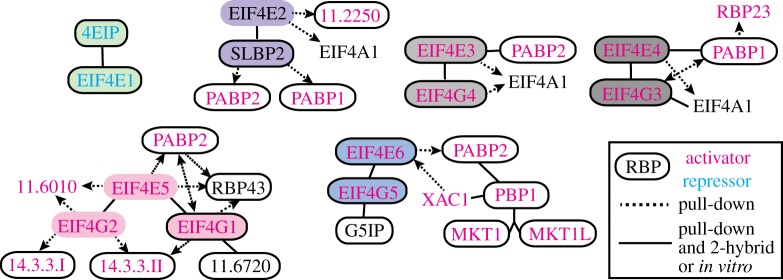Figure 4.
Interactions of cap-binding translation initiation complexes in T. brucei and Leishmania. The key is on the bottom right. The colours of the ovals identify different EIF4E interaction partners. Text colour codes for ‘activator’ (magenta) and ‘repressor’ (cyan) indicate whether the protein activates, or represses, gene expression when tethered within the 3′-UTR of a reporter mRNA in bloodstream-form T. brucei [41,167] (electronic supplementary material, Note 30). The solid frames indicate that the protein could be UV-cross-linked to poly(A)+ RNA in bloodstream-form T. brucei [41]. Gene numbers are from T. brucei, with the prefix ‘Tb927.’ removed. For results that rely on pull-down only, arrows point away from the bait protein. Suggested stage-specific interactions between Leishmania EIF4E1 and both EIF3 and EIF4G3 [168] are not shown. Binding activities of Leishmania EIF4E4 to modified caps are reported in [169,170]. Alternative names are G1-IP2 for RBP43, and G1-IP for Tb927.11.6720. References for pull-down and interaction results are as follows: T. brucei PABPs [155]; Leishmania and T. brucei EIF4E1 [168,171]; T. brucei EIF4E2 [172]; Leishmania EIF4G3 [173]; T. brucei and Leishmania EIF4E3 and EIF4E4 [168,174]; T. brucei EIF4E5 [175]; T. brucei EIF4E6 [176]. The tethering results for EIF4E5 and EIF4E6 are unpublished (L. Melo do Nascimento and C. Clayton 2019, unpublished data); note that the activities of these proteins when bound to the 5′ cap may not be the same as those seen in the tethering assay.

